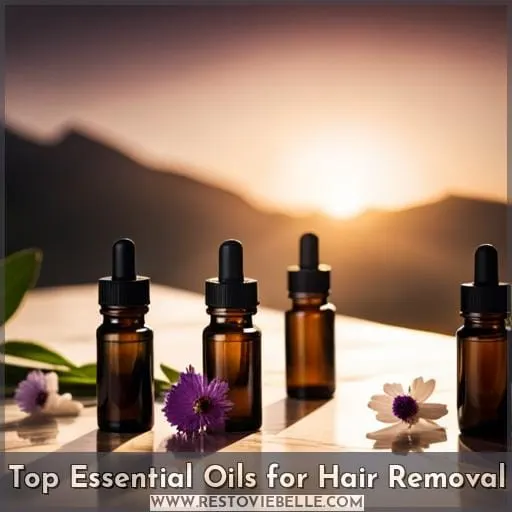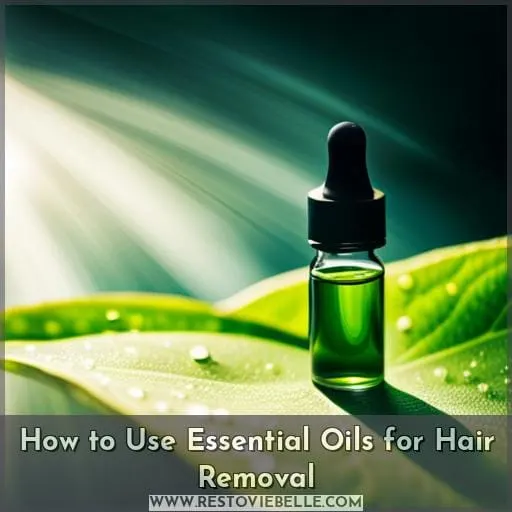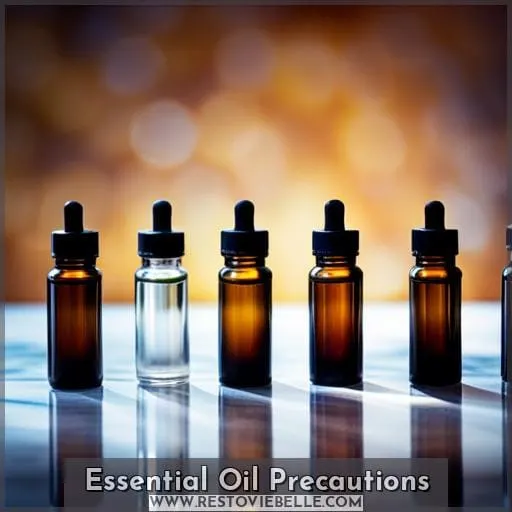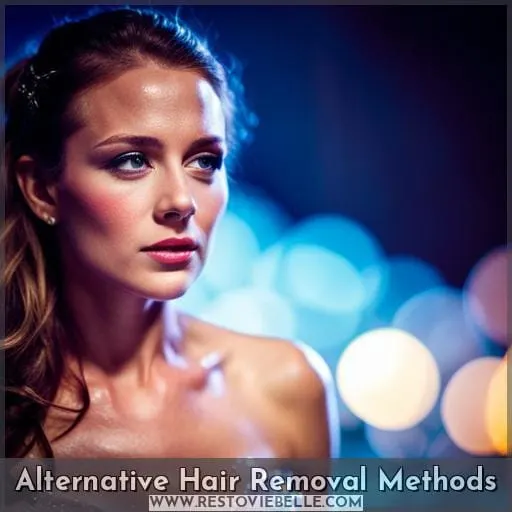This site is supported by our readers. We may earn a commission, at no cost to you, if you purchase through links.
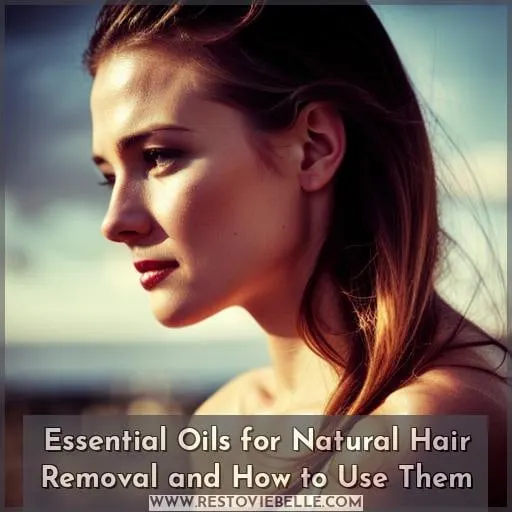 You know the struggle of unwanted hair. It creeps up in awkward places, irritates the skin, and is a pain to remove. But before reaching for the razor, try essential oils. Select a soothing lavender or invigorating grapefruit oil to soften hairs and soothe skin.
You know the struggle of unwanted hair. It creeps up in awkward places, irritates the skin, and is a pain to remove. But before reaching for the razor, try essential oils. Select a soothing lavender or invigorating grapefruit oil to soften hairs and soothe skin.
Apply diluted oil directly, let it work its botanical magic, then gently remove hairs. Essential oils are a simple, natural way to say see ya! to unwanted hair. Let’s explore how these aromatic oils can help you achieve smooth, hair-free skin.
Table Of Contents
Key Takeaways
- Lavender, grapefruit, and tea tree oils help soothe skin and inhibit hair regrowth when applied topically.
- Essential oils including lavender, peppermint, and tea tree can be substituted for chemical shaving creams.
- Before hair removal, essential oils can be diluted and used in body mists, masks, or added to shaving creams.
- Exfoliating with a loofah scrub and applying turmeric essential oil reduces inflammation from hair removal treatments.
Top Essential Oils for Hair Removal
You’ll find lavender, grapefruit, tea tree, and turmeric oils are top choices for hair removal. Diluted lavender soothes skin and prevents inflammation while antimicrobial grapefruit and tea tree clear pores and inhibit hair regrowth.
Anti-inflammatory turmeric also calms irritation from the process. These essential oils provide benefits during and after hair removal for smooth, soothed skin. Lavender’s anti-inflammatory properties prevent irritation while grapefruit and tea tree keep pores clear.
Turmeric also reduces inflammation. Using these natural oils can benefit your skin’s health and appearance if you choose to remove hair.
Lavender
You’ll feel a cooling, soothing sensation when gently massaging diluted lavender oil onto irritated skin after hair removal. Lavender’s sweet floral aroma relaxes the mind while its anti-inflammatory properties provide skin relief.
By increasing localized blood flow, lavender essential oil reduces swelling and sensitivity. Always dilute it with a carrier oil and perform a patch test before wider application. When used safely and consistently, lavender oil calms irritation post-hair removal.
Grapefruit
Look here, the sweet scent of grapefruit oil’s helpful for opening pores when diluted properly, but be mindful of spending time in sunlight after use since it may increase sun sensitivity. A 2020 case study in Aesthetic Dermatology illustrated how a woman experienced mild photodermatitis from using undiluted grapefruit oil before tanning.
- Dilute before applying topically
- Test for skin sensitivity first
- Avoid sun exposure after applying
Grapefruit oil boasts uplifting citrus aromas, valued in hair removal routines when handled wisely. Blending with lavender makes a pleasing pairing. However, grapefruit’s photosensitizing qualities necessitate caution.
Consult an aromatherapist to create personalized citrus oil blends that suit your skin type.
Tea Tree
Using tea tree oil on your skin may help reduce inflammation after hair removal procedures.
| Benefit | Explanation | Example |
|---|---|---|
| Disinfects | Kills bacteria on the skin | Prevents infections |
| Soothes | Calms inflammation | Reduces razor bumps |
| Moisturizes | Hydrates the skin | Mix with aloe vera |
Blending tea tree oil with lavender oil creates a calming, anti-inflammatory effect after hair removal.
Turmeric
Remember the turmeric facial mask we made last week? Adding turmeric to your hair removal regimen can provide anti-androgenic and soothing properties.
- Decrease inflammation
- Soothe irritation
- Slow regrowth
Mixing it with black seed or fennel oil can enhance these hair minimizing effects.
How to Use Essential Oils for Hair Removal
When using essential oils for hair removal, proper application is key for safety and effectiveness. You can apply them directly to the skin in a spray, mix them into a mask, or add them to your shaving cream.
As a Spray
Mix up a refreshing body mist using your favorite essential oil blends. For easy application before and after hair removal treatments, fill a spray bottle with distilled water, witch hazel, and aloe vera gel.
Add 10-15 drops of diluted essential oils like lavender, spearmint, or grapefruit. Shake well before misting over desired areas. Enjoy the aromatherapy benefits and custom scent.
In a Mask
Bask in silky smooth skin after smearing the aromatic blend over freshly washed skin.
- A deep cleansing mask unclogs pores and prepares skin for hair removal.
- Soothing oils reduce inflammation and sensitivity from prior procedures.
- Natural antiseptics prevent infection while promoting healthy hair regrowth.
Masking with essential oils before and after hair removal nurtures skin health for optimal results. Energizing scents uplift the spirit throughout the process. With regular use, you will emerge renewed and stubble-free.
As a Shaving Cream
Slathering your DIY blend of tingle-cutting oils on your pits instead of that phony shaving balm will have your skin smooth as a baby’s bottom.
| Essential Oil | Benefits for Shaving |
|---|---|
| Tea Tree | Antiseptic, reduces irritation |
| Lavender | Soothing, healing |
| Peppermint | Cooling, refreshing |
Ditch the chemicals and go au naturel with an aromatherapy shave cream. Your skin will thank you.
Essential Oil Benefits
Let’s ease into laser hair removal side effects gently. First, dilute and apply essential oils like lavender and tea tree to soften hair follicles prior to treatment. Next, blend anti-inflammatory oils like turmeric and evening primrose to reduce post-treatment inflammation when massaged into the skin.
Soften Hair
Lactic acid lotions smooth keratosis pilaris and radiate rejuvenated skin. Soothe follicles with evening primrose and fennel seed oils to naturally shrink hair. Relax as aromatic compounds penetrate the dermis, effectively softening strands.
Gentle techniques boost shine and suppleness, curing dead skin. Essential oil infusion optimizes results.
Reduce Inflammation
You’d be surprised how effectively a loofah scrub can reduce post-laser inflammation. The exfoliating fibers gently cleanse while stimulating circulation to soothe irritated skin. Certain essential oils further promote healing when blended into scrubs or lotions.
Anti-inflammatory and analgesic oils like turmeric, tea tree, and helichrysum provide natural relief. Herbal alternatives like these nourish the skin, reducing redness and sensitivity without chemicals.
With their soothing, anti-aging properties, essential oils make ideal additions to your post-treatment skincare routine.
Essential Oil Precautions
When using essential oils for hair removal, it’s crucial to dilute them properly and avoid photosensitizing oils before sun exposure. For example, dilute peppermint oil with a carrier oil like jojoba at a 1:4 ratio, and avoid applying grapefruit oil before going outside, as it can increase sun sensitivity.
Dilution
Gotta be real careful diluting those potent elixirs, hon. A little dab’ll do ya if you don’t wanna end up with a rash.
- Start with low dilutions of 1–3% essential oil.
- Do a patch test on a small area first.
- Avoid direct sunlight after applying photosensitive oils.
- Use carrier oils to buffer and enhance absorption.
- Consult an aromatherapist about safe blending ratios.
When using essential oils topically for hair removal, proper dilution is crucial to avoid irritation. High-quality oils can pack a punch, so go low and slow with concentrations, especially on sensitive skin.
With proper precautions, you can harness their antifungal and anti-inflammatory properties safely.
Photosensitivity
Stay alert, my friend, as we protect our bare skin from sun damage. Some essential oils make skin more sensitive to UV rays. Grapefruit, for example, is phototoxic. Apply sunscreen liberally before sun exposure, especially on areas treated with citrus oils.
Wear protective clothing and limit direct sunlight. Monitor skin reactions when using new oils. Blend photosensitive oils with sun-safe choices like lavender. With wise precautions, we can still benefit from essential oils’ soothing touch.
Alternative Hair Removal Methods
You’re looking for alternatives to traditional hair removal methods. Exfoliating prepares the skin, waxing pulls hair from follicles, and epilators mechanically grasp hairs. We’ll explore techniques like sugaring as well as essential oils that aid hair removal.
Exfoliating
Let’s exfoliate that rough skin before hair removal for optimal results. Exfoliating helps prevent ingrown hairs and other unwanted hair conditions by removing dead skin cells and clearing pores.
- Smoother, softer skin
- Improved hair removal results
- Reduced irritation and inflammation
Natural exfoliants like loofah sponges gently buff away dull skin for a rejuvenated complexion.
Waxing
You’re tearing the truth from its roots now. Waxing removes hair from the root for smooth skin. Exfoliate gently before waxing to avoid irritation. Avoid sun exposure and hot baths after waxing. Use aloe vera gel to soothe. Allow regrowth to 1/4 inch before rewaxing. It lasts longer than shaving and provides a close shave.
Start small – bikini line or underarms. Take painkillers beforehand if needed. Do not wax over varicose veins, moles, or warts. Wax with the grain first. Breathe deeply during the process. Let a pro do Brazilians until you gain experience.
Epilators
Scrubbing your skin with a loofah sponge before using an epilator helps lift hairs for easier removal. Epilators pull hair directly from the root. This slows regrowth compared to shaving, but can be more painful.
Test a small patch first to gauge your sensitivity. Rotating epilator heads grasp hairs of varying lengths. Slower than waxing overall, but more convenient for touch-ups. Some discomfort is normal at first.
Exfoliating and moisturizing post-epilation soothe skin and prevent ingrown hairs.
Conclusion
At the end of the day, essential oils can offer a natural way to remove hair without harsh chemicals. By softening strands and soothing skin, oils like lavender and grapefruit allow you to avoid razor burn.
But be careful – properly dilute oils and avoid sun exposure after using grapefruit oil. You may also want to explore waxing, exfoliating, and epilators for hairless happiness. Remember to moisturize after hair removal to maintain healthy skin. Using essential oils can help you ditch unwanted hair in a natural way.

